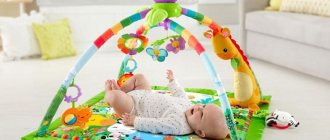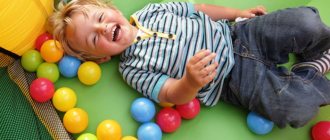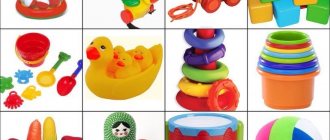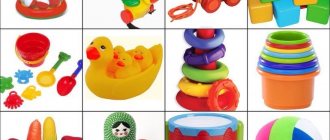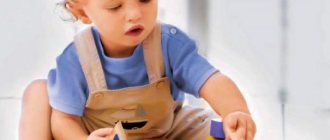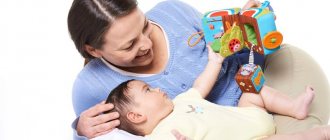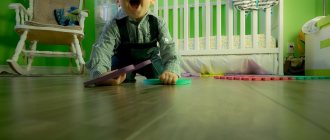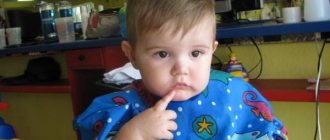1 4757 February 10, 2021 at 03:23 Author of the publication: Evgenia Astreinova, psychologist
The first year of your baby's life has passed. Left behind are diapers and undershirts, first feedings and other worries of early childhood. Now the little explorer is standing on his own feet. Getting ready to explore the big world. And parents have new questions: how to develop a child at 1 year old? What skills should he have at this age? What to play and how to keep a one-year-old child occupied at home during the day?
System-vector psychology helps to accurately determine the innate properties and talents of children. With its help, you can confidently guide and correct your baby's development.
Our article will be useful for you if:
- you want to keep up with the times, know the most effective developmental methods;
- you are worried about something in the behavior or development of your child’s skills at 1 year old, you are worried about whether the baby knows and can do enough;
- you want to successfully monitor your baby’s development and promptly offer him new games and activities;
- you are interested in how to identify and maximize a child’s innate talents, raise him to be a successful, fulfilled and happy person.
Motor development of a child per year and month
Most toddlers one year old or a little older are quite confident on their feet and can stand up without assistance and walk 10-20 steps to the goal. Moreover, girls usually try to simplify the task for themselves by moving along the furniture and holding onto it with their hands. And boys often sink back to the floor and quickly crawl, because they are doing it better so far, and this way they feel more confident.
If your child is not yet walking on his own at 1 year and 1 month, but he is absolutely healthy and crawls quickly, try to gently switch him to walking. Lead your baby, giving him two of your index fingers as support. Bring him to interesting objects located at his height so that the child understands that there are a lot of interesting things up there, and to get to them, you need to walk. Sitting at the other end of the room, call your son or daughter over to you. If the baby crawls, instead of approaching, do not show disappointment, just move away again, get on all fours, then rise to your feet, encouraging the child to repeat after you. Rejoice wildly when your baby comes up to you and hug him.
Little explorers and conquerors
A child aged one year and one month shows a keen interest in his home. He tries to examine everything that comes into view; often lifts his head up, and if he sees something interesting, he strives to get to the object. Young explorers are quite capable of conquering peaks located at a height of half a meter from the floor: they climb onto chairs, armchairs, sofas and stools. However, going down is always more difficult, so your little “climber”, sitting on a chair, may begin to whine and ask for help.
At this age, the child actively explores the properties of all objects that fall into his hands: he feels, tastes, knocks on something, throws it on the floor and looks at the result. The young researcher’s desire to open all the containers, pull out all the drawers and throw out all the contents with a joyful squeal turns into a real disaster. Picking up scattered things and putting them back is not the best solution. The baby will wait until you turn away, and will repeat his actions with delight, thinking that this is some kind of game. It's better to make most of the drawers in the house out of reach of your baby. Of course, this primarily concerns boxes with potentially dangerous items.
For any researcher, including such a young one, the concept of home is very important. The baby should wake up and fall asleep in a familiar, safe environment. Frequent moves and overnight stays outside the home slow down a child’s development. A sudden change of environment disorients the baby. It can even cause sleep disturbances. If you are planning a move, rearrangement or renovation, be close to the child at the moment of his awakening, and gradually introduce him to new objects around him.
Books
When conducting educational activities for children 1-2 years old, without a doubt you need to read books to them and show them pictures. At this age, children absorb all the information provided like a sponge. Even though their speech is not yet developed, everything new is accumulated in the brain. Soon the knowledge gained will spill out. You need to tell the children, show them, explain absolutely everything. It is very interesting for kids to look at in books what they have already encountered in their lives. Therefore, they begin to love them at an early age.
Basically, books for one-year-old children are somewhat similar. They are not replete with text; the main thing in them is colorful, beautiful pictures. There is an acquaintance with the outside world: family, toys, animals, seasons, colors, plants. How to choose a specific book? Listen to your own opinion. In terms of content, based on your artistic taste, you can choose anything. As for technical points:
- Illustrations must be of high quality. As little text as possible.
- Preference for short poems and fairy tales. The child will not be able to listen for a long time if the text is very large, he will quickly lose interest.
- The book must be completely safe. Do not buy dubious publications that have a strong smell or washable colors. This can harm the baby's health.
It is difficult to single out the “best” educational books for a 1-year-old child. The modern market is overfilled with these products. You can give preference to our old, well-proven fairy tales, which were favorites in every family. But it’s not a fact that your baby should like the same thing. Modern children differ in many ways from older generations in their development, so watch your child and note for yourself what he prefers.
Speech development of a child at 1 year and 1 month
The entire speech arsenal of a baby over one year old can be divided into passive and active vocabulary. The first dictionary contains those words whose meaning is clear to the child, but he does not pronounce them. And words from the active dictionary are always on his lips: mom, dad, baba, ghoul, byaka and other simplified definitions.
Most parents try to expand their children’s passive vocabulary as much as possible and transfer as many words as possible from the passive vocabulary to the active one. This is a great start, but try not to overload your baby with information. During the learning process, incidents happen: you ask your son or daughter to show a cat, and he shows you a goat. Don’t be upset, the child understood well what you asked him to do, he’s just more attracted to the goat at the moment, and he wants to show you something really funny and interesting.
Intellectual development of the baby per year and month
What does a child understand at this age? He already knows what is edible and what is inedible, what is hard and what is soft, what is dangerously spicy and hot. But this knowledge is not enough to avoid household injuries with one hundred percent certainty, relying on your own experience and intelligence. Blocking a child's access to all potentially dangerous objects in the house is the most important task for parents. And whenever a dangerous situation arises in the presence of a child, you need to explain to him how to behave.
For example, a child walked up to an ironing board with a hot iron on it. Instead of grabbing your child’s hand in fear, scolding him and dragging him aside, calmly demonstrate to him what the danger is: put your finger to the iron, pretend that you have been burned and are in pain. Then make a protective gesture and warn that the baby will face similar troubles if he touches the iron.
Prohibitions and punishments
Bans for a child of one year and one month do not apply in principle. If someone tells you that their son or daughter unquestioningly obeys prohibitions at this age, know: the child is simply afraid. He is afraid of shouting, swearing or punishment. The kid doesn’t understand why he can’t do what is forbidden. You just can’t – that’s all. This is a very bad way of parenting. At this age, only one form of prohibition can be used effectively and without harm to the psyche - complete blocking of access. The child should not climb into this box - put it on the mezzanine.
As for punishments, not everything is so simple here either. At the age of one year and a little older, children still do not know how to foresee the consequences of their actions, and do not feel guilty for their bad actions. For example, your son or daughter bit a peer in the heat of play. What to do? Under no circumstances should you shout, scold, or send a negative emotional message to your child: you are bad.
You need to demonstratively feel sorry for the bitten baby. Let your child realize what happened, evaluate his actions and draw a conclusion. In a year and a month, the intellect is developed enough for this.
You need to react to any child’s misdeed in such a way that he understands: you do not consider him to be bad, you only condemn his action, and at the same time have no doubt that he will improve. After all, your baby is smart, good, kind and the best in the world. The child must be confident in your love and that he is a treasure for you. Punishments at such a young age are absolutely unacceptable, moreover, meaningless. If, for example, you put your baby in a corner or deprive him of his favorite toys because he broke a vase, he will draw only one conclusion: my mother suddenly decided that I was bad. A child of one year and a month is not yet able to trace the direct cause-and-effect relationship between the offense committed and the punishment for it.
Developing fine motor skills
The nerve endings that control finger coordination are located in the brain, in close proximity to the center responsible for speech. Therefore, any finger games will help the baby start talking faster.
How to develop motor skills of a 1 year old child? Give your baby a light massage of his palms and fingers, while mixing up the mechanical stroking with various nursery rhymes and songs. See how he likes it.
You can give tasks. Play with beads. Try to teach your child to throw them into the neck of a plastic bottle and then take them out. Never leave him alone with small objects, as he may accidentally swallow them.
Make the tasks more difficult gradually. A fun activity for children would be to push pasta and other thin objects into the holes of the colander.
Buy an educational table for children from 1 year old, it provides games for fine motor skills.
At this age, children love to play with dough. Allow your baby to “help” you in the kitchen. Let him play with the dough and make anything out of it, imitating you, rolling balls and pancakes. All these entertainments are not just interesting, but also very useful.
How to organize the daily routine of a 1 year 1 month old child
Sound sleep and good nutrition are so important for a baby that it is difficult to overestimate their role. The harmonious physiological and mental development of a child can be ensured only when he is not bothered by the troubles of life: not enough sleep, a seething stomach, uncomfortable clothes. Let's discuss in detail the issues of organizing sleep and nutrition for children one year and one month old.
Restful sleep
Surprisingly, even at this age, “owls” and “larks” are found among children. The first ones go to bed at 8-9 pm, but already at 4 am they usually wake up their mother and ask for breastfeeding. And the latter can be capricious until 11, but wake up for the first time at about 6 in the morning. Most babies after one year continue to divide their nightly sleep into “two doses”; this is normal. During the day, children of this age also sleep twice, and sleep lasts at least an hour. In total, babies of 1 year and 1 month spend 12-13 hours a day sleeping.
There is debate among experts as to whether it is necessary to put a child on the potty when he wakes up at night. On the one hand, the sooner you stop using diapers, the better. On the other hand, many children, after undressing and placing their warm butts on a cold potty, whine for a long time and cannot fall asleep again. Therefore, many modern mothers take pity on their child’s peace and nerves and do not put him on the potty at night.
Bedtime and morning wake-up rituals are very important for your baby. In the evening he needs to be bathed or at least washed and changed into clean clothes. Then hold it in your arms, talk tenderly, sing a song, and put it on your chest if desired. The room should have a calm environment, dim light, clean air, and a comfortable temperature. It is strictly not recommended to carry the child in your arms around the room and rock him to sleep, and put him in the crib only after he falls asleep. Another six months will pass, and your little one will weigh much more, and will be capricious for much longer. Going to bed will turn into hours of agony. Pediatricians recommend allowing children to fall asleep in their crib on their own from birth. Shaking and rocking a cradle or stroller with a baby is unacceptable - it upsets the vestibular system and does nothing but harm.
In the morning, as soon as the child wakes up, go up to him and greet him affectionately. Every day should start with your smile, warm hugs and kisses. Then the baby will be in a good mood all day. There is no need to immediately “pull” the child out of his sleepy state: put him on the potty, drag him to the bathroom, comb his hair and dress him. Give him five minutes to cuddle in your arms or lie in his crib.
Proper nutrition
Almost all children aged 1 year and 1 month are still breastfed, but already receive extensive complementary foods: porridge, fruit and vegetable purees, yoghurts and curds, lean meat and fish, preferably steamed. There are very convenient drinking mugs that you can teach your baby to use.
Organizing a meal correctly is not an easy task. It is best to put the child in a special high chair with a feeding table, tie a bib on him, put a plate on him, give him a spoon, sit next to him at the kitchen table and eat too. Let your child slowly learn to repeat after you. There will be a lot of “disgusting”, but what can you do? If your baby gets tired of fighting with food and gets upset, help him and feed him with a spoon.
While eating, the child does not need to be distracted by unnecessary conversations, toys and a working TV. Let him focus. If you spoon feed your baby every time, trying to speed up the process and avoid confusion, he will not soon learn to eat on his own. Be sure to praise your child for eating well. And under no circumstances scold him if he does poorly. Then the child will generally refuse to sit down at the table and start eating.
Natural departures
Full control over the processes of urination and defecation is established by the child only by the age of three. Therefore, you should not be too upset about wet panties and sheets. Moreover, there is no need to scold the baby because of them. But it is necessary to praise every time the child goes to the potty. It is also important to form in the baby the correct attitude towards the administration of natural needs.
The potty should not stand in the middle of the living room or change its place every five minutes. Place it in the toilet or behind the crib. Let the child, firstly, know where his potty is, and secondly, understand that the process of emptying the intestines or bladder is an intimate process. Parents don't pee in the middle of the room or walk around the house without pants.
How to play with a child at 1 year 1 month
Most of all, a baby at this age is interested in those objects with which his parents constantly interact: kitchen utensils, mobile phone, computer, TV remote control, and so on. He loves to copy your actions: “call”, cook porridge, feed the doll this porridge. Provide him with his own toys, utensils, a telephone, as well as dolls and animals. It is important to choose the right toys for a child aged one year and one month.
All toys must be made from environmentally friendly and safe materials. Minimum of sharp corners, synthetic fur and hair. Toys should not contain small parts that could get into the respiratory tract. Any child at this age needs a small doll: both boys and girls. It should be a baby doll, that is, an imitation of a baby, made of soft rubber plastic, with moving limbs and a head without hair. The doll's clothes are very simple - a hat, a jacket and pants that your child can take off and put on himself.
In addition to the doll, a baby aged one year and one month should have at least a dozen different toys in the form of animals, birds and fish. As for cars, only large, reliable trucks and dump trucks are suitable, on which you can ride a doll or a bear. Small cars are dangerous: a child can step on them, break off a part and swallow it.
It is worth paying special attention to educational toys: cubes, pyramids, nesting dolls, various boards with shaped holes into which you need to insert a suitable object. Be patient while showing your baby how to play with them. Praise for every achievement.
Cartoons. Communication with peers
In the second year of life, the child is just beginning his acquaintance with the outside world, so watching TV should not take him much time. At this age, you can only watch cartoons for a very short time, and, of course, the plots should be appropriate. Limit your screen time and don't let watching become your only pleasure and entertainment. Choose educational cartoons for children aged 1 year and older wisely and with the right approach. Modern rental stores offer a huge number of children's cartoons, both Russian and foreign. Give preference to our “cartoons”; their kind and educational stories will interest your child. The generation of “Pokemon” and “monsters” has already led our society to the point where children simply moved to live in gaming networks. It's time to stop this. From an early age, start limiting what your baby watches and strictly control his tastes in the future. For children 1 year old, such educational cartoons as “Lev the Truck,” “Tini Love,” “Turtle Aha-Aha,” and “Auntie Owl” are perfect. Shows that will help you remember colors, numbers, letters, names of objects and animals are also useful at this age.
Do not forget that the harmonious development of a child can only occur in communication with peers. Do not lock your baby in the apartment, do not limit his communication with mom, dad, grandparents. The child must become accustomed to society; the process of learning about the world around him is much faster this way. By playing with peers, the baby learns something useful and new. Visit playgrounds, development centers, and playrooms with him.
